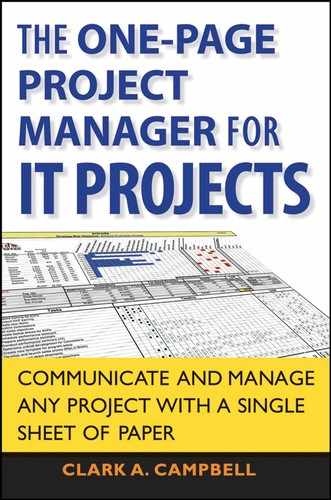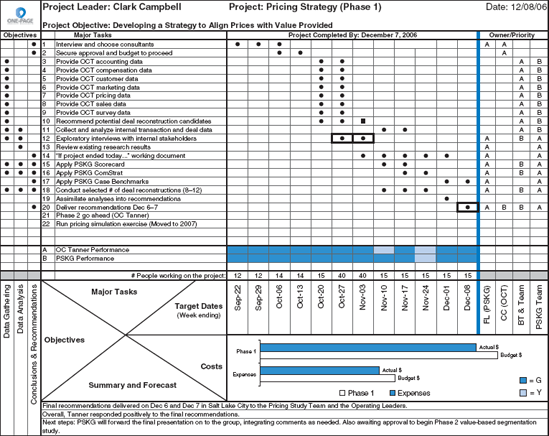Until now, I've referred to the One-Page Project Manager (OPPM) solely as a communication tool. It is that, of course. But in fact, it can be used as something more—a tool to communicate and a tool to manage. I use the OPPM to manage consultants, whom we have hired for a wide variety of projects, but who are particularly common with IT projects.
Recently, we hired an international consulting firm to help us with a pricing project. We wanted to evaluate our pricing strategy to better align our prices with the value we provide our clients.
The OPPM I created for the project had three uses:
It communicated to upper management and other interested parties how the project was progressing, which is the traditional use of the tool;
It helped us manage the consultants; and
It was used by the consulting firm to manage us. Yes, we got some of our own medicine back when the consulting firm turned the tables and used the OPPM to help them keep us going in the proper direction. In fact, all parties benefited from using the OPPM.
The project involved two phases. The OPPM samples found in this chapter show the tool completed for the first phase and as a plan waiting to be implemented for the second phase. I chose these two phases so you could see the OPPM completed and empty.
Notice the two OPPMs (Figures 7.1 and Figures 7.2) are fairly standard-issue types, the sort we have seen in other chapters with a few variations. Let's look at Phase 1 first. The header contains the Name of the project, Pricing Strategy (Phase 1); the Project Leader and the Project Objective; Developing a Strategy to Align Prices with Value Provided.
In the matrix portion (in the lower left), you'll notice Target Dates (Week ending). This line shows the OPPM followed the project in one-week intervals and it ran for 12 intervals or 12 weeks. At the very lower left-hand corner were the project's subobjectives: Data Gathering, Data Analysis, and Conclusions and Recommendations. In order to reach our Project Objective, we needed to accomplish these three subobjectives.
The column headed Major Tasks lists 22 quantitative tasks (numbered 1 through 22) plus two qualitative tasks (labeled A and B).
Copyright O.C. Tanner 2008. To customize this document, download it to your hard drive from the following web site: www.onepageprojectmanager.com. The document can be opened, edited, and printed using Microsoft Excel or another popular spreadsheet application.
On the right-hand side near the bottom are the Owners. This is different than in other OPPMs we've discussed. I've said before that owners should always be employees of your company, not outsiders such as consultants. As with any good rule, this rule can and should be broken in a project such as the one we're discussing. The first owner is FL. She is, in fact, an employee of the consulting firm, not of O.C. Tanner. The next two owners, CC and BT & Team are O.C. Tanner employees. The "Team" is the group of our employees who were working on the project. The last owner, PSKG Team, is a comparable team from the consulting firm. We arranged to have half the owners from our side (our lead and our team) and half from the consultant's side (their lead and their team) because this was such a collaborative effort. We absolutely needed the consultants to take ownership of some tasks, which is why they are on the OPPM.
Copyright O.C. Tanner 2008. To customize this document, download it to your hard drive from the following web site: www.onepageprojectmanager.com. The document can be opened, edited, and printed using Microsoft Excel or another popular spreadsheet application.
This OPPM shows the project at its completion. All the tasks were completed on time. Note that Task 10, Recommend potential deal reconstruction candidates (which refers to taking all correspondence from a deal and reconstructing the process required from initial offer to final contract), has a square in the column for the week ending Nov.03. We realized as the project progressed that this expanded task would take a week longer to complete than the two weeks originally allotted, so a square was inserted. When the task was completed, the square was filled in.
Take a look at Task 12: Exploratory interviews with internal stakeholders. The consultants interviewed managers, directors, and VPs of the company to get a collection of opinions about the strengths and weaknesses of our processes. This was done over two weeks (the weeks ending Oct. 27 and Nov. 03) and the circles have rectangular borders around them. The reason: We use the borders to delineate major milestones, tasks that must be completed for the project to move forward. Task 20, Deliver recommendations Dec. 6-7 also has a border around it for the same reason. These borders are placed around the squares at the beginning of the project so everyone who reads the OPPM knows which tasks are key. This major milestone heavy box may be used for significant critical path events or for any other reason requiring special focus or attention.
You will find an unusual line under the tasks, labeled # People working on the project. We wanted to keep track of how many of our people (this does not include consultants) were working on the project at any given time. These numbers are a head count and are not full-time equivalents.
One unique aspect of this OPPM can be found in the qualitative tasks. The consultant, who evaluates how well O.C. Tanner is performing, completes task A. Task B is completed by us to evaluate how the consultants are performing. When you do a project with a consultant, there is mutual dependency, and this fact needs to be communicated throughout the consultant's team and your project team. We did not reproduce this OPPM in color, but you probably will. Trust me, when everyone can see, in bright green, yellow and red, how the consultants are judging you (and you are judging the consultants), it tends to motivate performance. This is one way this OPPM is a management tool—our performance and the consultants' performance are clearly depicted.
The fact that the consultants are grading you is an incentive to your team and, of course, the consultants like it. The consultants graded us during two weeks (weeks ending Nov. 10 and Nov. 24) with yellow because information they needed to do their work was not received in a timely manner. We graded the consultants' performance yellow during the week ending Nov. 24 because they had challenges getting some of their methodology and tools to work properly. Notice that the last two weeks of the project are filled in with green, indicating both of these inadequacies were rectified.
Another unusual aspect of this OPPM comes under Costs. When dealing with consultants, frequently there are the consultants' professional fees, which are fixed, and then there are expenses, such as for hotels, travel, and photocopying. The chart shows bars and numbers to carefully track actual spending compared to budget. This is another way the tool is used to help manage the consultants. Having everyone looking at expenses helps control costs.
Proceeding to Phase 2 depended on the successful completion of Phase 1. Summary and Forecast noted that the first phase was successfully completed and that we were awaiting approval to begin Phase 2.
The next OPPM (Figure 7.2) shows Phase 2 three months into the project. I will not discuss every aspect of it, since it is similar to the OPPM we just discussed, but there are some differences, which are worth pointing out. Note that the Project Objective was expanded to read: Developing segment-specific offers to meet customer needs. This was done to explain how the focus of the project had gone from creating a strategy to executing the strategy.
The Major Tasks section is different than other OPPMs in that the tasks, which number 30, are divided into four sections shown in gray: Training Modules (Responsibility of TT), Survey Design (Responsibility of CC & DS), Survey Execution (Responsibility of CC & DS) and Survey Analysis (Responsibility of CC & DS). This was done to clearly delineate to the reader the four essential parts of the project. With this format, the reader can easily and quickly follow the project through its essential parts toward its conclusion. The gray areas are where we wanted to emphasize that there are three subparts to this project (design, execution, and analysis) all focused around the segment work. As with the OPPM for Phase 1, the qualitative tasks A and B have O.C. Tanner grading the consultants and the consultants grading O.C. Tanner.
As with the OPPM for Phase 1, this OPPM has major milestones delineated by boldly bracketed boxes. These include: Task 8, Finish questionnaire draft; Task 18, Delivery of final data from market research vendor; and Task 28, Deliver final recommendations.
The project's subobjectives (lower left-hand corner) are now: Create tools, conduct research and analysis, logistics/training/plans. These represent the new objectives of this phase.
The budget, as with Phase 1, is divided into professional fees and miscellaneous expenses. The expenses on this phase are so much higher than the first because they include the fees of a third vendor, a market research firm, which was to be secured by the consultant and paid out of these expenses.
These are the basics of Phase 2's OPPM.
Since many readers will deal with consultants during their careers, let me say a few words about these useful, though sometimes exasperating, outside vendors. Managing consultants brings with it a level of uncertainty combined with a mutual interdependence.
You hire a consultant to do something you cannot do yourself. By hiring them, you will eventually increase your own confidence in your ability to accomplish a new task, and you will increase your competence to deliver that task successfully; but not at first. The OPPM is a management and communication tool that makes it easier to tell each other how things are going and what is expected next.
The creation of the OPPM provides an essential meeting of the minds at the beginning of the consulting engagement. This tool, when dealing with a consulting project, is not just primarily aimed at an internal audience, but now includes, as a major goal, communicating to an external audience. You and the consultants come to a much clearer consensus on the project ' s scope, budget, and time line. And it facilitates a mutual commitment to meet those objectives. This is enormously valuable. The tool helps get a project off from the get-go with everyone reading from the same page (pun intended).
As with every OPPM, you also use the tool to communicate about the project to upper management.
By using the OPPM, we in effect consulted the consultants. They liked the OPPM so much, they bought copies of my first book, hired us to train them in its use, and then started using it themselves to manage their own projects world wide. The consultants found with the OPPM an important take-away that they now use to improve the performance of their projects and the communication with their clients.
Further, as in other types of projects, we found the status, steering, and other meetings we had with the consultants to be more efficient and effective than they would have been without the OPPM. This is another way in which the OPPM is a management as well as communication tool.
The OPPM is a profoundly valuable tool for managing consultants and communicating the essential elements of their work as a project progresses.


